Catapult Aircraft Merchant (CAM) ships equipped with Hawker Sea Hurricanes
Catapult Aircraft Merchant (CAM) ships equipped with Hawker Sea Hurricanes

(RAF Photo)
On merchant ships equipped with catapults, Sea Hurricanes were often deployed as standard fighters, despite being nearly worn out. In a last-ditch effort, these aircraft would embark on one final flight, knowing there was no place to land. Instead, pilots would ditch their planes in the sea, hoping for a fortunate rescue. With the eventual arrival of escort carriers, this perilous practice was halted, providing a safer alternative for naval aviation operations.

(RAF Photo)
Hawker Sea Hurricane Mk. I, (Serial No. Z4936), coded 'KE-M, of the Merchant Ship Fighter Unit is lowered onto the training catapult at Speke, Liverpool, for a training launch. At the back of the catapult are some of the firing rockets used to power the launch cradle.

(RN Photo)
Catapult Aircraft Merchant (CAM) ships were equipped with a Hawker Sea Hurricane mounted on a catapult launcher. They were used in convoys as an emergency stop-gap until sufficient escort carriers became available. The CAM ships mounted a rocket-propelled railing that launched a single aircraft dubbed a "Hurricat" or "Catafighter" to destroy or drive away an attacking bomber. Normally the Hurricane fighter would be lost when the pilot then bailed out or ditched in the ocean near the convoy. CAM ships continued to carry their normal cargoes after conversion. The concept was developed and tested by the five fighter catapult ships, commissioned as warships and commanded and crewed by the Royal Navy, but the CAM ships were merchant vessels, commanded and crewed by the Merchant Navy.
When a CAM ship arrived at its destination, the pilot usually launched and landed at a nearby airfield to get in as much flight time as possible before his return trip. Pilots were rotated out of CAM assignments after two round-trip voyages to avoid the deterioration of flying skills from the lack of flying time during the assignment. CAM sailings were initially limited to North American convoys with aircraft maintenance performed by the RCAF at Dartmouth, Nova Scotia.
In total, there were nine combat launches. Nine German aircraft were destroyed (four Condors, four Heinkels and a Junkers 88), one damaged and three chased away. Eight Hurricanes were ditched and only one pilot was lost.

(RN Photo)
Catapult Aircraft Merchant (CAM) ship with a Hawker Sea Hurricane mounted on a catapult launcher.
CAM ships were Second World War-era British merchant ships used in convoys as an emergency stop-gap until sufficient escort carriers became available. CAM ship is an acronym for catapult aircraft merchant ship. They were equipped with a rocket-propelled catapult launching a single Hawker Hurricane, dubbed a "Hurricat" or "Catafighter" to destroy or drive away an attacking bomber. Normally the Hurricane fighter would be lost when the pilot then bailed out or ditched in the ocean near the convoy. CAM ships continued to carry their normal cargoes after conversion.
The concept was developed and tested by the five fighter catapult ships, commissioned as warships and commanded and crewed by the Royal Navy – but the CAM ships were merchant vessels, commanded and crewed by the Merchant Navy.
The German Luftwaffe had Focke-Wulf Fw 200 Condor aircraft with a range of nearly 2,000 nautical miles (3,700 km; 2,300 mi). After the Fall of France, these aircraft could operate from western France against British merchant ships in the Atlantic. Flying from Bordeaux–Mérignac Airport, Fw 200s of I/KG40 could reach the convoy lanes west of Britain while staying outside the range of British land-based fighters. The Royal Navy had no aircraft carriers available to provide close air cover for the convoys. The Fw 200s could shadow convoys, directing U-boat attacks on them, or drop bombs on convoy ships, without opposition and to deadly effect.
To counter this threat, the Admiralty developed the fighter catapult ship – a converted freighter, crewed by naval sailors, carrying a single Hawker Hurricane fighter. When an enemy bomber was sighted, the fighter would be launched into the air with rockets, and fly up to destroy or drive away the bomber. Being large and slow, the Fw 200 became a rather vulnerable target. After the combat, the fighter pilot would bail out or ditch in the ocean near the convoy, and be picked up if all went well.
The Admiralty had already experimented with this system. They ordered 50 rocket-propelled aircraft catapults to be fitted to merchant ships. The planes were Hurricane Mark Is, converted to Sea Hurricane Mk. IAs.
The pilots for these aircraft were drawn from the Royal Air Force (RAF). The RAF formed the Merchant Ship Fighter Unit (MSFU) on 5 May 1941 in RAF Speke by the River Mersey in Liverpool.[1] Wing Commander E.S. Moulton-Barrett commanded the unit providing training for volunteer pilots, fighter direction officers (FDOs), and airmen. After training, MSFU crews were posted to Liverpool, Glasgow, or Avonmouth where they assisted in loading their Hurricanes onto the catapults. Each team consisted of one pilot for Atlantic runs (or two pilots for voyages to Russia, Gibraltar, or the Mediterranean Sea), with one fitter, one rigger, one radio-telephone operator, one FDO, and a seaman torpedoman who worked on the catapult as an electrician. CAM ships (Sea Hurricanes) were quite useful on the Gibraltar/Africa run. Heading to the US quickly put the Focke-Wulf Fw 200 Condor out of range.
MSFU crews signed ship's articles as civilian crew members under the authority of the civilian ship's master. The ship's chief engineer became responsible for the catapult, and the first mate acted as catapult duty officer (CDO), responsible for firing the catapult when directed. The single Hurricane fighter was launched only when enemy aircraft were sighted and agreement was reached using hand and flag signals between the pilot, CDO, and ship's master.
The first four or five ships were taken into Royal Navy service as "auxiliary fighter catapult ships", and later conversions were officially named CAMs and crewed by merchant sailors. The first CAM ship, Michael E, was sponsored by the Royal Navy while the RAF MSFUs were working up. After a trial launch off Belfast, Michael E sailed with convoy OB 327 on 28 May 1941. She was sunk by U-108 on 2 June. The first RAF trial CAM launch was from Empire Rainbow, at Greenock on the River Clyde on 31 May 1941; the Hurricane landed at Abbotsinch. Six CAM ships joined convoys in June 1941. When a CAM ship arrived at its destination, the pilot usually launched and landed at a nearby airfield to get in as much flight time as possible before his return trip. Pilots were rotated out of CAM assignments after two round-trip voyages to avoid the deterioration of flying skills from the lack of flying time during the assignment.
CAM sailings were initially limited to North American convoys with aircraft maintenance performed by the Royal Canadian Air Force at Dartmouth, Nova Scotia. CAM ships sailed on Gibraltar and Freetown convoys beginning in September 1941, after an aircraft maintenance unit was established at the RAF base at North Front, Gibraltar. No CAM aircraft were provided during January and February 1942 after it proved impossible to maintain the catapult-mounted aircraft in flying order during the North Atlantic winter. CAM sailings resumed on 6 March 1942 on North Atlantic convoys and in April on the Arctic Russian convoys with an RAF aircraft maintenance unit in Archangelsk.
CAM shipsEight CAM ships were requisitioned from private owners, two of which were sunk:DaghestanDaltonhallEastern CityHelencrestKafiristanMichael E (sunk)NovelistPrimrose Hill (sunk).27 CAM ships were Ministry of War Transport owned Empire ships, ten of which were sunk:Empire Burton (sunk)Empire CliveEmpire DarwinEmpire DayEmpire Dell (sunk)Empire Eve (sunk)Empire FaithEmpire FlameEmpire FoamEmpire FranklinEmpire GaleEmpire HeathEmpire Hudson (sunk)Empire Lawrence (sunk)Empire MoonEmpire MornEmpire OceanEmpire Rainbow (sunk)Empire RayEmpire Rowan (sunk)Empire Shackleton (sunk)Empire SprayEmpire Spring (sunk)Empire StanleyEmpire SunEmpire TideEmpire Wave (sunk).
Take-off procedure. The trolley receiving bar was removed at dawn.The airmen started the aircraft and warmed up the engine at intervals.The pilot climbed into the aircraft when enemy aircraft were reported.The ship hoisted the international flag code F when the decision was made to launch. (CAM ships were usually stationed at the head of the outboard port column of a convoy so they could manoeuvre into the wind for launch.)An airman removed the pins, showed them to the pilot, and took them to the Catapult Duty Officer (CDO).The pilot applied 30 degree flaps and 1/3 right rudder.The CDO raised a blue flag above his head to inform the ship's master of his readiness to launch.The ship's master manoeuvred the ship into the wind and raised a blue flag above his head to authorise the launch. (The ship's master stood on the starboard bridge wing to avoid the catapult rocket blast which sometimes damaged the port side of the bridge.)The CDO waved his blue flag indicating he was ready to launch upon a signal from the pilot.The pilot opened full throttle, tightened the throttle friction nut, pressed his head back into the head-rest, pressed his right elbow tightly against his hip, and lowered his left hand as a signal to launch.The CDO counted to three, waited for the bow to rise from the trough of a swell, and moved the switch to fire the catapult rockets.
CAM combat launchesFor the combat launches from Royal Navy fighter catapult ships, see Fighter catapult ship § FCS combat launches.Date Ship/convoy Pilot Outcome1 Nov 1941 SS Empire Foam / HX 156 FO Varley Focke-Wulf Fw 200 chased off; pilot recovered by HMS Broke[1][4]26 Apr 1942 SS Empire Morn / QP 12 FO JB Kendal Blohm & Voss BV 138 chased off and Junkers Ju 88 shot down (Ju 88A-4 "4D+IT" of III./KG 30); Kendal died from injuries received while bailing out[1][4]26 May 1942 SS Empire Lawrence / PQ 16 PO Hay Two Heinkel He 111s shot down; Hurricane shot down, pilot wounded and recovered by HMS Volunteer[1][4]14 Jun 1942 SS Empire Moon / HG 84 PO Sanders Focke-Wulf Fw 200 chased off; pilot recovered by HMS Stork[1][4]18 Sep 1942 SS Empire Morn FO AH Burr Two Heinkel He 111s destroyed; pilot flew to the Russian Keg Ostrov (ru) aerodrome[1][4]1 Nov 1942 SS Empire Heath / HG 91 FO N Taylor Focke-Wulf Fw 200 shot down; pilot nearly drowned before recovery[1][4]28 Jul 1943 SS Empire Darwin / SL 133 FO JA Stewart Focke-Wulf Fw 200 destroyed; pilot recovered by HMS Leith[1][4]28 Jul 1943 MV Empire Tide / SL 133 FO PJR Flynn Focke-Wulf Fw 200 destroyed; pilot recovered by HMS Enchantress[1][4]In total, there were eight combat launches from CAM ships. Eight German aircraft were destroyed (three Fw 200 Condors, four Heinkel 111s and a Junkers 88), one damaged and three chased away. Eight Hurricanes were ditched and one pilot lost.Additionally, one Condor was destroyed in August 1941 by a Hurricane launched from a Royal Navy Fighter Catapult Ship. This was flown by Robert W. H. Everett.
As adequate numbers of escort carriers became available, CAM sailings on North American and Arctic Russian convoys were discontinued in August 1942. The aircraft maintenance unit was withdrawn from Archangelsk in September 1942. Catapults were removed from 10 of the 26 surviving CAM ships while the remaining 16 continued to sail with the Mediterranean and Freetown convoys. Headquarters RAF Fighter Command ordered all MSFUs to be disbanded commencing 8 June 1943. The combat launches from homeward bound convoy SL 133 were from the last two operational CAM ships to sail; the last MSFU was disbanded on 7 September 1943. Twelve of the 35 CAM ships had been sunk while sailing on 170 round trip voyages. Two more ships, Cape Clear and City of Johannesburg, were briefly fitted with dummy catapults and aircraft for deception purposes in late 1941.
(Wikipedia) Barker, Ralph. HURRICATS : the incredible true story of britain's 'kamikaze' pilots of world war two. (SILVERTAIL Books, 2019)Hague, Arnold. The Allied Convoy System 1939–1945. (Naval Institute Press, 2000)Mitchell, W H, and Sawyer, L A. The Empire Ships. London, New York, Hamburg, Hong Kong: Lloyd's of London Press Ltd., 1990) Pauly, John; Truebe, Carl E.; Wilde, Doug & Wilterding, John H. "Question 14/48: Catapult Armed Merchant Ships". (Warship International, 2012). Wise, James E. Jr. "Catapult Off – Parachute Back". (United States Naval Institute Proceedings, 1974)
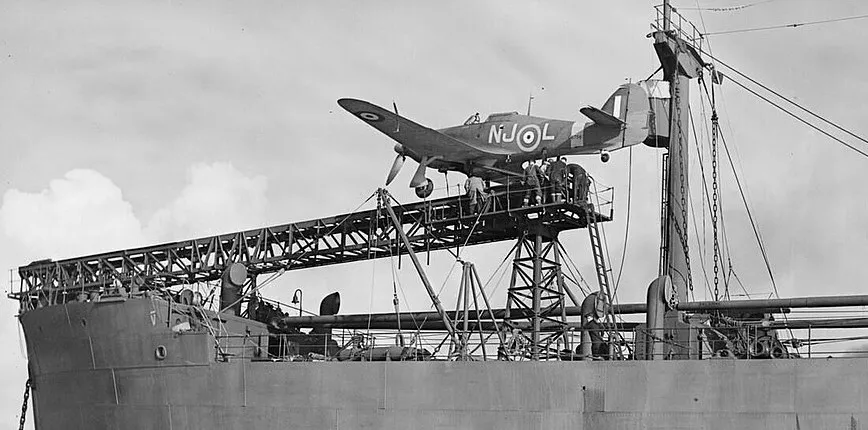
(IWM Photo A 9421)
Hawker Hurricane Mk. IA on the catapult of a CAM (Catapult Armed Merchant) Ship at Greenock, Scotland. The first RAF trial CAM launch was from SS Empire Rainbow at Greenock on the River Clyde on 31 May 1941, the Hurricane landed at Abbotsinch.
CAM ships were ordinary merchant ships fitted with a rocket driven catapult on the forecastle. They carried one Mk. 1(a) Hurricane with minimum modifications and flown by volunteer RAF pilots, known as Sea Hurricanes, ‘Catafighters’ or ‘Hurricats’. Quickly put into service in 1941 before the first escort carriers appeared with the aim of driving off or shooting down German bombers and reconnaissance aircraft, particularly Focke-Wulf Fw 200 Condors. Once flown off, the pilot usually had to ditch and hope tobe picked up or make for the nearest friendly shore. The first ships were requisitioned for Naval Service as Auxiliary Fighter Catapult Ships and sailed under the White Ensign. Later CAM-ships were merchantmen.
CAM sailings were initially limited to North American convoys with aircraft maintenance performed by the Royal Canadian Air Force at Dartmouth, Nova Scotia. CAM ships sailed on Gibraltar and Freetown convoys beginning in September 1941, after an aircraft maintenance unit was established at the RAF base at North Front, Gibraltar. No CAM aircraft were provided during January and February 1942 after it proved impossible to maintain the catapult-mounted aircraft in flying order during the North Atlantic winter. CAM sailings resumed on 6 March 1942 on North Atlantic convoys and in April on the Arctic Russian convoys with an RAF aircraft maintenance unit in Archangelsk. (Wikipedia)

(IWM Photo)
Hawker Sea Hurricane Mk I (Serial No. V6733), of the Merchant Ship Fighter Unit, on the fo'c'sle catapult on board Catapult Armed Merchantman (CAM ship) SS Empire Darwin, in a convoy heading for North Africa. Note the flaps pre-selected in the take-off position. The catapult was angled to starboard over the ship's bows to prevent the blast from its rockets hittin…
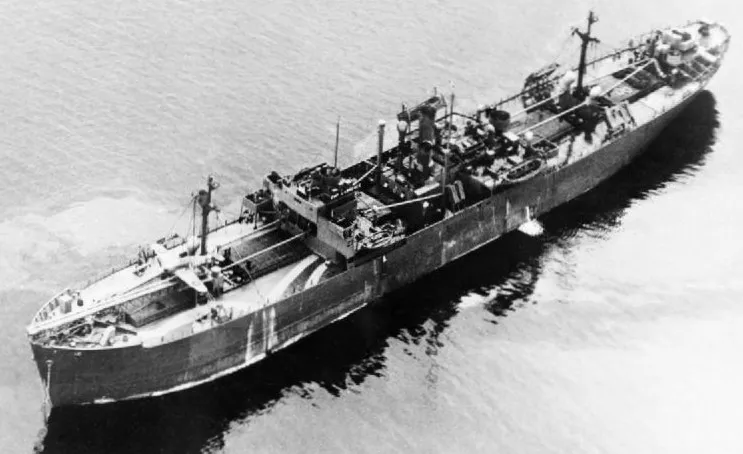
(IWM Photo, FL 11425)
SS Empire Lawrence at anchor, with a Hawker Hurricane mounted on its catapult, c1941.

(RN Photo)
Catapult Aircraft Merchantman (CAM Ship) seen here at anchor in Halifax Harbour, Nova Scotia. 35 ships were fitted with catapults in total, 8 were privately owned and 27 were British Ministry of Transport owned Empire ships, this is likely one of the latter.
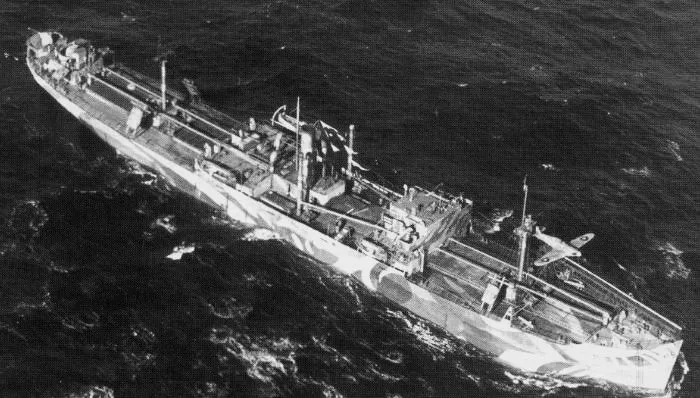
(IWM Photo)
Overhead view of SS Empire Darwin in a dazzle camouflage, showing her catapult and Sea Hurricane to advantage. The catapults were fitted in such a manner so as not to affect the ships’ normal operations in any way, they could still transport their standard cargos. On 28JUL43 Empire Darwin launched her Sea Hurricane which was credited with the destruction of an FW 200 Condor. The Hurricane pilot, PO Stewart, bailed out over the convoy and was rescued.
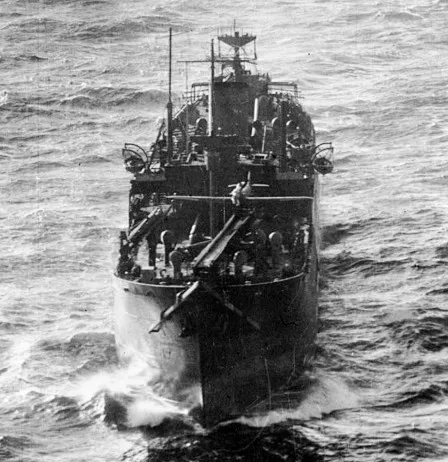
(IWM Photo)
SS Empire Spray leading a pair of standard merchantmen as part of a convoy formation. Convoys were organized based upon the cruising speed of the merchant ships, it was common to include 25 ships or more plus escorts. The CAM ships were operational until the Summer of 1943 when sufficient numbers of Escort Carriers became available
According to Cdr Rippon in ‘Evolution of Engineering in the Royal Navy’, Volume 2, some 35 CAM-ships made about 175 voyages in two years - twelve were lost, eight catapult launchings were made, six enemy aircraft shot down and one RAF pilot lost. Requisitioned Auxiliary Fighter Catapult Ships included ‘Ariguani’, ‘Maplin’ and two more, which were lost in 1941: HMS Patria and HMS Springbank.
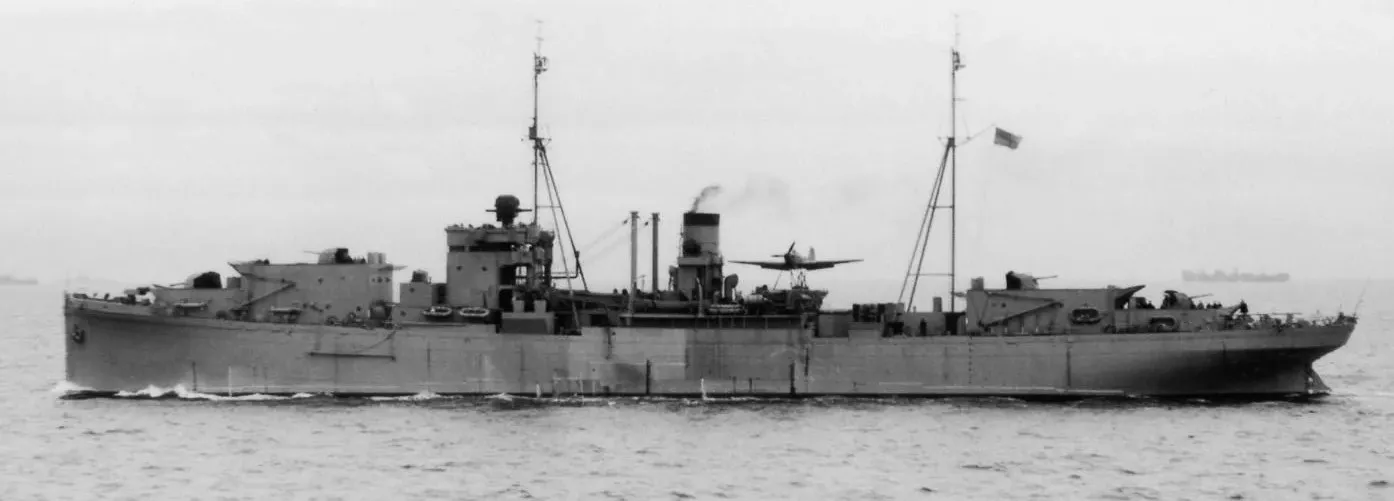
(RN Photo)
Fairey Fulmar onboard the Fighter Catapult Ship HMS Springbank, similar in concept, size and presumably appearance, to HMS Patia. Note the Fulmar on the catapult amidships. HMS Springbank, (5,150t, completed 1926, Capt C H Godwin), lost on 27 September 1941, North Atlantic (49.10N, 20.05W), torpedoed by German ‘U.201’ (Schnee); 32 crew lost.





